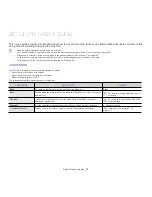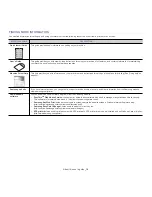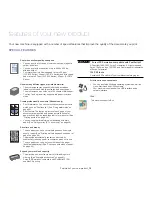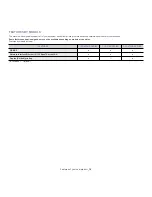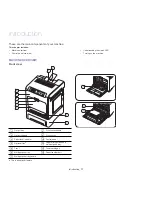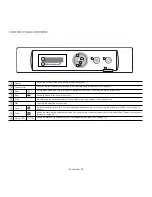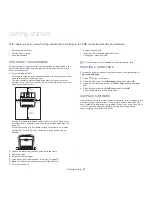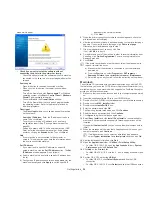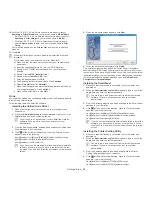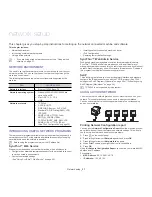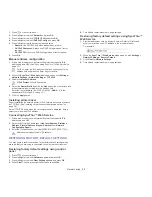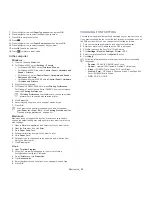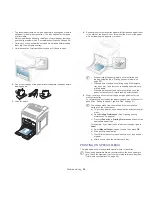
Getting started
_ 25
16.
For Mac OS X 10.3, if Auto Select does not work properly, select
Samsung
in
Printer Model
and your machine name in
Model Name
.
•
For Mac OS X 10.4, if Auto Select does not work properly, select
Samsung
in
Print Using
and your machine name in
Model
.
•
For Mac OS X 10.5~10.6, if Auto Select does not work properly,
select
Select a driver to use...
and your machine name in
Using
.
Your machine appears on the
Printer List
, and is set as the default
machine.
17.
Click
Add
.
If the printer driver does not work properly, uninstall the driver and
reinstall it.
Follow steps below to uninstall the driver for Macintosh.
a) Make sure that the machine is connected to your computer and
powered on.
b) Insert the supplied software CD into your CD-ROM drive.
c) Double-click CD-ROM icon that appears on your Macintosh
desktop.
d) Double-click the
MAC_Installer
folder.
e) Double-click the
Installer OS X
icon.
f)
Enter the password and click
OK
.
g) The Samsung Installer window opens. Click
Continue
.
h) Select
Uninstall
and click
Uninstall
.
i)
When the message which warns that all applications will close on
your computer appears, Click
Continue
.
j)
When the uninstall is done, click
Quit
.
Linux
You need to download Linux software packages from the Samsung website
to install the printer software.
Follow the steps below to install the software.
Installing the Unified Linux Driver
1.
Make sure that the machine is connected to your computer and
powered on.
2.
When the
Administrator Login
window appears, type in root in the
Login
field and enter the system password.
You must log in as a super user (root) to install the machine
software. If you are not a super user, ask your system
administrator.
3.
From the Samsung website, download and unpack the Unified Linux
Driver package to your computer.
4.
Click
at the bottom of the desktop. When the Terminal screen
appears, type in the following:
[root@localhost root]#tar zxf [FilePath]/UnifiedLinuxDriver.tar.gz
[root@localhost root]#cd [FilePath]/cdroot/Linux
[root@localhost Linux]#./install.sh
If you do not use the graphical interface and failed to install the
software, you have to use the driver in the text mode. Follow
the steps 3 to 4, and then follow the instructions on the terminal
screen.
5.
When the welcome screen appears, click
Next
.
6.
When the installation is complete, click
Finish
.
The installation program has added the Unified Driver Configurator
desktop icon and the Unified Driver group to the system menu for your
convenience. If you have any difficulties, consult the on screen help that
is available through your system menu or can otherwise be called from
the driver package Windows applications, such as
Unified Driver
Configurator
or
Image Manager
.
Installing the SmartPanel
1.
Make sure that the machine is connected to your computer and
powered on.
2.
When the
Administrator Login
window appears, type in root in the
Login
field and enter the system password.
You must log in as a super user (root) to install the machine
software. If you are not a super user, ask your system
administrator.
3.
From the Samsung website, download and unpack the Smart Panel
package to your computer.
4.
Click
at the bottom of the desktop. When the Terminal screen
appears, type in the following:
[root@localhost root]#tar zxf [FilePath]/SmartPanel.tar.gz
[root@localhost root]#cd [FilePath]/cdroot/Linux/smartpanel
[root@localhost smartpanel]#./install.sh
If you do not use the graphical interface and failed to install the
software, you have to use the driver in the text mode. Follow
the steps 3 to 4, and then follow the instructions on the terminal
screen.
Installing the Printer Setting Utility
1.
Make sure that the machine is connected to your computer and
powered on.
2.
When the
Administrator Login
window appears, type in root in the
Login
field and enter the system password.
You must log in as a super user (root) to install the machine
software. If you are not a super user, ask your system
administrator.
3.
From the Samsung website, download and unpack the Printer
Setting Utility package to your computer.
4.
Click
at the bottom of the desktop. When the Terminal screen
appears, type in the following:
[root@localhost root]#tar zxf [FilePath]/PSU.tar.gz
[root@localhost root]#cd [FilePath]/cdroot/Linux/psu



